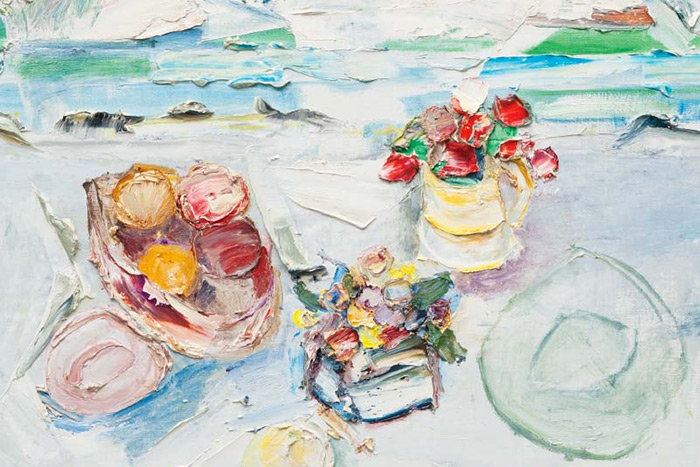Get to Know Dan's Papers Cover Artist Manoucher Yektai

This week’s Dan’s Papers cover artist Manoucher Yektai’s paintings were on display recently as part of Guild Hall’s year-end exhibitions featuring local artists. Yektai’s work wasn’t the only art showing throughout Guild Hall’s museum space, which included works by another Dan’s Papers cover artist, Pamela Topham.
In fact, Manoucher wasn’t even the only Yektai on display. Manoucher’s two sons, Nico and Darius, are also artists and both of them had pieces on display. Nico, a furniture designer by trade, was showing a large-scale curvilinear bench; Darius, a sculptor, showed “The Ascension,” a sculpture made of small fragments of wood pieced together and jutting upward. On the surrounding walls were Manoucher’s paintings, still-lifes and portraits thick with expressionist brushstrokes.
But before Manoucher Yektai was a painter, he was a poet, writing in his native Farsi. He was first introduced to painting as an art form while a student at Tehran University in Iran, when he met Mehdi Vishkaei, considered one of the pioneers of Iranian modern painting. As Niki Yektai, Manoucher’s wife, recounts, “Vishkaei invited Manoucher to his studio and began a portrait of him.

He showed Manoucher two postcards, one of Cezanne and one of Van Gogh. Manoucher chose Cezanne as the better painter and feels the same today.” The two discussed art at length, and Manoucher, practically overnight, became an artist. “Vishkaei opened up a totally new world to Manoucher,” Niki said, adding, “Manoucher went home to tell his mother he was a painter.” One can only imagine his mother’s response.
Yektai, now in his late 90s, dreamed of going to Paris and, after graduating in 1945, decided to do so. “He took a long circuitous route during World War II,” his wife tells us. He ended up in New York for a brief time, where he studied at Ozenfant’s studio on 20th Street and at the Art Student League, before finally arriving in Paris. “Although much impressed with Paris,” Niki says, “he realized New York ‘is where it’s at.’”
After two years studying at Paris’s Ecole des Beaux Arts, Manoucher made the move back to New York in 1947. There he became a member of the 8th Street Club and friendly with many Abstract Expressionists, among them Jackson Pollock and Willem de Kooning. As art critic Thomas McEvilley notes in a biographical sketch of Yektai, the journey through three cultures, from a painter’s perspective, seemed clear in its meaning: “From Iran where, under Islamic strictures about imagery, free artistic expression was not available, first…to the ripe ambience of the School of Paris, then (more permanently) to the fledgling excitement of the emerging New York School.”
Like his Abstract Expressionist friends, “Manoucher does not draw on the canvas before painting,” Niki says. “He’s not a painter who goes regularly to the studio and he does not paint every day.” She quotes Manoucher: “At the moment of disgust of myself and despair, I finally attack the canvas,” which, she points out, is always on the floor. “He straddles the canvas and paints.”
Throughout the years, Manoucher never stopped writing poetry. “He feels,” Niki says, “it’s the same pursuit as his painting, just in a different medium.” She adds that when he takes breaks from painting, “which have lasted as long as two years,” he goes back to poetry.
For more on this artist, visit yektai.com.




